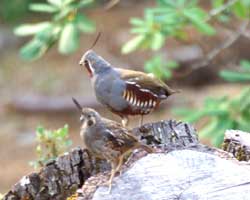By Susan Sharma
 This ground-dwelling, seed eater is endemic to western Himalayan foothills. The bird is globally treatened, probably extinct. The Himalayan quail was last observed in June 1868 at Jerepani, India. Although
the critically endangered bird has eluded sighting since 1876, wildlife experts and ornithologists are not willing to write off the bird, especially after several other species thought to have gone extinct have made a reappearance after several decades. (
eg. Jerdon's Courser, Forest Owlet).
This ground-dwelling, seed eater is endemic to western Himalayan foothills. The bird is globally treatened, probably extinct. The Himalayan quail was last observed in June 1868 at Jerepani, India. Although
the critically endangered bird has eluded sighting since 1876, wildlife experts and ornithologists are not willing to write off the bird, especially after several other species thought to have gone extinct have made a reappearance after several decades. (
eg. Jerdon's Courser, Forest Owlet).
The earliest authentic record of the mountain quail's, zoologically called Ophrysia superciliosa, existence dates back to 1836, when a British sportsman, tucker, collected a pair from the vicinity of Mussoorie.
The last mountain quail, a female, was shot on the ridge known as Sherka-Dhanda, overlooking the Nanital lake, in 1876. There is no reliable evidence to suggest that the bird has been sighted since.
Described as a shy bird, the Himalayan quail is believed to be a resident of grassland or scrubland and oak forests at an altitude of 1,650 to 2,500 metres. Drastic changes in vegetation and land use pattern and other forms of disturbances have been responsible
for the decline in the population of this species.
According to famous British ornithologist A O Hume, the bird's irregular appearance in areas around Mussoorie and Nainital is due to the fact that it is possibly a migrant from the well wooded south-eastern portion of Chinese Tibet during severe winters. However
later ornithologists felt the bird is a poor flier and hence could not have migrated.
Apart from scientific expeditions, amateurs are also looking for the elusive bird. Mr. Yasser Arafat a regular contributer to 'Wildbytes', is on the trail of finding the Himalayan quail. Wildlywise.com are arranging 12 days expeditions in quail territory. We
all hope that this cute pheasant will be rediscovered soon.
Schedule I, Part III of the Indian Wildlife (Protection) Act, 1972 lists rare and endangered birds which are totally protected throughout the country, live or dead or part thereof. They include Andaman Teal,
Sarus crane, Assam Bamboo Partridge, Bazas, Bengal Florican, Blacknecked Crane, Blood Pheasants, , Eastern White Stork, Forest spotted owlet, Jerdon's Courser, Cheer Pheasant, Great Pied Hornbill, Hawks, Great Indian Bustard, Hooded Crane, Hornbills, Houbara
Bustard, Humes Bartailed Pheasant, Indian Pied Hornbill, Lammergeier, Large Falcons, Large Whistling Teal, Monal pheasant, Narcondam Hornbill, Nicobar Megapode, Nicobar Pigeon, Osprey, Peacock-Pheasant, Peafowl or Indian Peafowl, Pinkheaded Duck, Scalter's
Monal Pheasant, Siberian White Crane, Tibetan Snowcock, Tragopan-Pheasant, Whitebellied Sea Eagle, White-eared Pheasant, White Spoonbill, and Whitewinged Wood Duck.